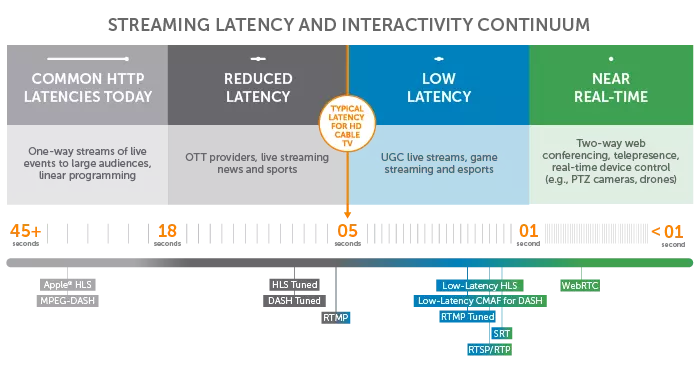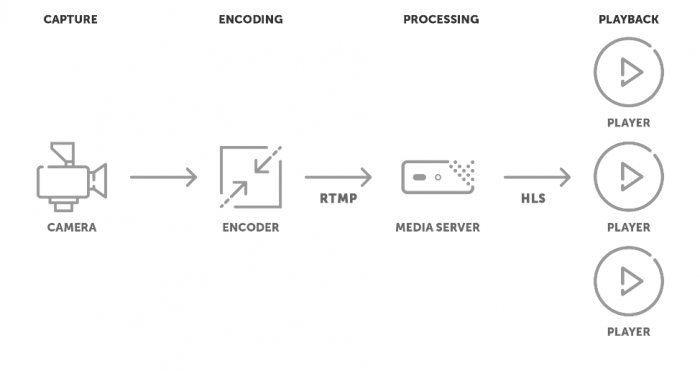Streaming Protocols: Everything You Need to Know (Update)
This article is a cross posting of our partner (Wowza)’s article: Streaming Protocols: Everything You Need to Know (Update) .
This article will give a summary of the original article above.
Please also refer the original full article to get details more.

When it comes to online video delivery, RTMP, HLS, MPEG-DASH, and WebRTC refer to the streaming protocols used to get content from point A to B. Because different protocols play a role in different types of broadcasts, it’s not always fair to say that one is better than another.
Differentiating between all the acronyms is challenging for anyone entering the video streaming space. Add in the fact that each protocol varies slightly in terms of compatibility, latency, security — the list goes on — and things get downright puzzling.
In this article, we spell out exactly what a protocol is, the ten most common video streaming protocols in 2022, and considerations when selecting the right technology for your use case.
What Is a Streaming Protocol?
Online video delivery uses both streaming protocols and HTTP-based protocols. Streaming protocols like Real-Time Messaging Protocol (RTMP) transport video using dedicated streaming servers, whereas HTTP-based protocols rely on regular web servers to optimize the viewing experience and quickly scale. Finally, emerging HTTP-based technologies like Apple’s Low-Latency HLS seek to deliver the best of both options by supporting low-latency streaming at scale.
- Traditional Video Streaming Protocols
- Real-Time Messaging Protocol (RTMP)
- Real-Time Streaming Protocol (RTSP)
- Adaptive HTTP-Based Streaming Protocols
- HTTP Live Streaming (HLS)
- Low-Latency HLS
- Dynamic Adaptive Streaming over HTTP (MPEG-DASH)
- Low-Latency CMAF for DASH
- Microsoft Smooth Streaming
- Adobe HDS (HTTP Dynamic Streaming)
- New Technologies
- SRT (Secure Reliable Transport)
- WebRTC (Web Real-Time Communications)
Traditional Video Streaming Protocols
Traditional streaming protocols, such as RTSP and RTMP, support low-latency streaming. But they aren’t natively supported on most endpoints (e.g., browsers, mobile devices, computers, and televisions). Today, these streaming formats work best for transporting video between and IP camera or encoder and a dedicated media server.

As shown above, RTMP delivers video at roughly the same pace as a cable broadcast — in just over five seconds. RTSP/RTP is even quicker at around two seconds. Both formats achieve such speed by transmitting the data using a firehose approach rather than requiring local download or caching. But because very few players support RTMP and RTSP, they aren’t optimized for great viewing experiences at scale. Many broadcasters choose to transport live streams to the media server using a stateful protocol like RTMP. From there, they can transcode it into an HTTP-based technology for multi-device delivery.
Adaptive HTTP-Based Streaming Protocols
Streams deployed over HTTP are not technically “streams.” Rather, they’re progressive downloads sent via regular web servers. Using adaptive bitrate streaming, HTTP-based protocols deliver the best video quality and viewer experience possible — no matter the connection, software, or device. Some of the most common HTTP-based protocols include MPEG-DASH and Apple’s HLS.
New Technologies
Last but not least, new technologies like WebRTC and SRT promise to change the landscape. Similar to low-latency CMAF for DASH and Apple Low-Latency HLS, these protocols were designed with latency in mind.
WebRTC
As the speediest technology available, WebRTC delivers near-instantaneous voice and video streaming to and from any major browser. It can also be used end-to-end and thus competes with ingest and delivery protocols. The framework was designed for pure chat-based applications, but it’s now finding its way into more diverse use cases.
Scalability remains a challenge with WebRTC, though, so you’ll need to use a solution like Wowza’s Real-Time Streaming at Scale feature to overcome this. The solution deploys WebRTC across a custom CDN to provide near-limitless scale. This allows broadcasters to reach a million viewers with sub-500 ms delivery — a once impossible feat.
Workflow: Real-Time Streaming at Scale for Wowza Video

Considerations When Choosing a Streaming Protocol
Selecting the right media streaming protocol starts with defining what you’re trying to achieve. Latency, playback compatibility, and viewing experience can all be impacted. What’s more, content distributors don’t always stick with the same protocol from capture to playback. Many broadcasters use RTMP to get from the encoder to server and then transcode the stream into an adaptive HTTP-based format.

Media streaming protocols differ in the following areas:
- First-mile contribution vs. last-mile delivery
- Playback support
- Encoder support
- Scalability
- Latency
- Quality of experience (adaptive bitrate enabled, etc.)
- Security
Contribution vs. Delivery
RTMP and SRT are great bets for first-mile contribution, while both DASH and HLS lead the way when it comes to playback. On the flip side, RTMP has fallen entirely out of favor for delivery, and HLS isn’t an ideal ingest format. That’s why most content distributors rely on a media server or cloud-based video platform to transcode their content from one protocol to another.
Playback Support
What’s the point of distributing a stream if viewers can’t access it? Lacking playback support is the reason RTMP no longer plays a role in delivery to end users. And ubiquitous playback support is the reason why HLS is the most popular protocol today.
Encoder Support
The inverse of playback support is encoder support. RTMP maintains a stronghold despite its many flaws due to the prevalence of RTMP encoders already out there. Similarly, RTSP has stayed relevant in the surveillance industry because it’s the protocol of choice for IP cameras.
WebRTC is unique in that it can be used for browser-based publishing and playback without any additional technologies, enabling simple streaming for use cases that don’t require production-quality encoders and cameras.
Scalability
HLS is synonymous with scalability. The widely-supported HTTP-based protocol leverages web servers to reach any device worth reaching today. But what it delivers in scalability, it lacks in terms of latency. That’s because latency and scalability have traditionally been at odds with one another. New technologies like Real-Time Streaming at Scale, however, resolve this polarity.
Latency
Low-Latency HLS, low-latency CMAF for DASH, and WebRTC were all designed with speedy delivery in mind. Anyone deploying interactive video environments should limit themselves to one of these three delivery protocols.
Quality of Experience
While real-time delivery is crucial to some niche video experiences, high-quality delivery has become table stakes. Viewers no longer appreciate smooth, high-resolution streams. They simply expect it. And your best bet for ensuring a top-notch user experience is using a protocol that supports adaptive bitrate streaming. This is a core technology deployed by HLS and DASH.
Security
Last but not least, you’ll want to consider content protection. Encryption and digital rights management (DRM) come standard with HLS and DASH. WebRTC, on the other hand, is secured by the browser — but it lacks DRM capabilities and standard out-of-the-box security measures for broadcasting workflows. So, you’ll want to keep this in mind when architecting your workflow.
Conclusion
What’s the best protocol for video streaming in 2022? That’s up to you.
The right video technologies vary depending on each business’s needs. Instead of looking for the best protocols, you should look for the video platform that provides the most flexibility.
Having a wide range of protocols to choose from is essential for anyone looking to reduce latency, increase playback compatibility, and even address the challenges of remote video contribution. What’s more, many video engineers today are building hybrid workflows that employ a mish-mash of protocols at ingest and delivery.
Video now powers businesses in every industry, which is why prescriptive streaming workflows and rigid technologies no longer do the trick. But you’re in luck. Wowza’s flexible video platform supports a wide range of protocols and can be customized to your needs.
Simply contact us today to talk to an expert about the best way to architect your streaming workflow or start a free trial.